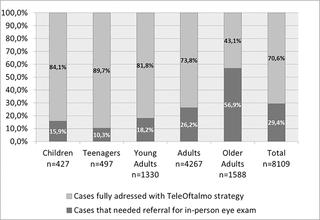PLOS ONE ( IF 3.7 ) Pub Date : 2020-04-02 , DOI: 10.1371/journal.pone.0231034 Aline Lutz de Araujo 1, 2 , Taís de Campos Moreira 3 , Dimitris Rucks Varvaki Rados 1 , Paula Blasco Gross 1 , Cynthia Goulart Molina-Bastos 1 , Natan Katz 1, 4 , Lisiane Hauser 1 , Rodolfo Souza da Silva 1 , Sabrina Dalbosco Gadenz 5 , Rafael Gustavo Dal Moro 1 , Felipe Cezar Cabral 3, 4 , Lucas Matturro 3 , Cássia Garcia Moraes Pagano 3 , Amanda Gomes Faria 3 , Maicon Falavigna 3 , Ana Célia da Silva Siqueira 1 , Paulo Schor 2 , Marcelo Rodrigues Gonçalves 1, 6 , Roberto Nunes Umpierre 1, 6 , Erno Harzheim 6, 7

|
Purpose
To determine whether teleophthalmology can help physicians in assessing and managing eye conditions and to ascertain which clinical conditions can be addressed by teleophthalmology in primary care setting.
Methods
We evaluated the resolution capacity of TeleOftalmo, strategy implemented in the public health system of southern Brazil. Resolution capacity was defined as the ability to fully address patients’ eye complaints in primary care with remote assistance from ophthalmologists. Data from tele-eye reports were collected over 14 months. Resolution capacity was compared across different age groups and different ocular conditions.
Results
Overall, 8,142 patients had a tele-eye report issued in the study period. Resolution capacity was achieved in 5,748 (70.6%) patients. When stratified into age groups, the lowest capacity was 43.1% among subjects aged ≥65 years, while the highest was 89.7% among subjects aged 13–17 years (p<0.001). Refractive error (70.3%) and presbyopia (56.3%) were the most prevalent conditions followed by cataract (12.4%) and suspected glaucoma (7.6%). Resolution capacity was higher in cases of refractive error, presbyopia, spasm of accommodation and lid disorders than in patients diagnosed with other condition (p<0.001).
Conclusions
With telemedicine support, primary care physicians solved over two-thirds of patients’ eye or vision complaints. Refractive errors had high case resolution rates, thus having a great impact on reducing the number of referrals to specialty care. Teleophthalmology adoption in primary-care settings as part of the workup of patients with eye or vision complaints promotes a more effective use of specialty centers and will hopefully reduce waiting times for specialty referral.
中文翻译:

使用远程医疗支持巴西初级保健医生管理眼部疾病:TeleOftalmo项目。
目的
为了确定远眼科是否可以帮助医生评估和管理眼部疾病,并确定在初级保健机构中远眼科可以解决哪些临床疾病。
方法
我们评估了Teleoftalmo(在巴西南部的公共卫生系统中实施的策略)的解决能力。解决能力的定义是在眼科医生的远程协助下,能够完全解决患者在初级保健中眼部不适的能力。远视报告的数据收集了14个月。比较了不同年龄组和不同眼部状况的分辨能力。
结果
在研究期间,总共有8142名患者发表了远视报告。5,748(70.6%)位患者达到了分辨能力。按年龄分组时,年龄≥65岁的受试者的最低能力为43.1%,而年龄13-17岁的受试者的最高能力为89.7%(p <0.001)。屈光不正(70.3%)和老花眼(56.3%)是最普遍的疾病,其次是白内障(12.4%)和可疑青光眼(7.6%)。屈光不正,老花眼,痉挛性痉挛和眼睑疾病的分辨能力要高于被诊断为其他疾病的患者(p <0.001)。
结论
在远程医疗支持下,初级保健医生解决了三分之二以上患者的眼睛或视力不适。屈光不正的病例解决率很高,因此对减少转诊到专科护理的人数有很大影响。在患有眼疾或视力障碍的患者进行检查时,在初级保健机构中采用远眼科,可以更有效地利用专科中心,并有望减少专科转诊的等待时间。


























 京公网安备 11010802027423号
京公网安备 11010802027423号